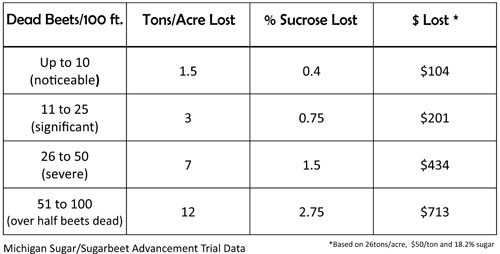Evaluate effectiveness of Rhizoctonia control in sugarbeets
Growers should evaluate effectiveness of their Rhizoctonia control program in sugarbeets during late August or early September.
In Michigan, Rhizoctonia root and crown rot is the most prevalent root disease in sugarbeet production. This disease in significant quantities will reduce tonnage, sugar content and can affect pile storage. Implementing the proper control management strategy can pay great dividends. Generally, late August or early September is an excellent time to evaluate potential yield, quality and income losses from this disease. New strategies may need to be implemented for next year if assessment shows an economic loss.
Michigan State University Extension Sugarbeet Advancement would recommend that every sugarbeet field be evaluated for potential Rhizoctonia impact. This can easily be implemented by randomly flagging 100 foot of row in at least six locations in each field. Count dead and dying beets in each location. Dead beet carcasses are easy to determine and often leave holes in the ground. Dying beets are normally very yellow with roots either partially or completely covered with rot. These plants normally can be wiggled in the soil or can be easily kick out of the ground. Often beets can have some Rhizoctonia spots on the roots and appear to have normal foliar appearance. Visually detecting those plants is nearly impossible and should not be included in the counts.
The average amount of dead or dying beets should be determined from all locations. Refer to Table 1 to determine potential impact of Rhizoctonia in each field. This chart was developed by Jim Stewart, Research Agronomist from Michigan Sugar Company, combining both Michigan Sugar small trial data and Sugarbeet Advancement field trials. Multiple years, locations and varieties were combined to formulate this data. The Rhizoctonia level and impact is only an estimate and can vary depending on variety tolerance, population and growing season.
Table 1. Influence of Rhizoctonia root rot on sugarbeet yield, quality and grower income

It is very important to recognize the Rhizoctonia resistance of the variety that is being evaluated. If there is even a ‘noticeable’ amount in a field with a resistant variety, then it may end up a big problem with a susceptible ‘high yielding variety’. In the 2013 Sugarbeet Advancement Variety Trials, the Rhizoctonia dead beet counts for the hottest varieties were around ten times higher than the most resistant varieties. This would give an indication of what Rhizoctonia levels could be if a grower switched to a susceptible variety without altering their management plan.
Conversely, some of the nematode varieties provide high yields. It may be better to have nematode tolerance and give up some yield to Rhizoctonia. Nematode infested fields with a history of Rhizoctonia often do best with a nematode tolerant variety and two Quadris applications. Refer to the REACh Variety Trial Results to determine variety resistance.
If the disease impact is greater than desired, then next year’s management plan may need to be altered. This may include applying Quadris either in-furrow or foliar, if you are not applying Quadris already. Consider a two spray system which includes in-furrow and a 6 to 8 leaf application. Over time, this option has given the most consistent and positive results. Switching to a more tolerant Rhizoctonia variety in combination with a Quadris spray program will give very good results, particularly under heavy disease pressure. Select varieties carefully as some of the most tolerant varieties may lack genetically in yield and quality or nematode tolerance.



 Print
Print Email
Email




